50 Years Of A Singapore Tiger

 Pacific International Line (PIL) has grown very rapidly over five decades from a small breakbulk shipping operator from Singapore to Jakarta and Bangkok into a worldwide operator of large container ships of up to 11,800 TEU capacity. It has been a Top Twenty container ship line since 2006, a significant achievement even in the rapidly expanding ‘Tiger’ economy of Singapore. PIL made the successful transition from a breakbulk operator to container shipping in the early 1980s, and has not looked back when powering ahead to expand into new container shipping trade lanes and in alliances with other Top Twenty container ship operators
Pacific International Line (PIL) has grown very rapidly over five decades from a small breakbulk shipping operator from Singapore to Jakarta and Bangkok into a worldwide operator of large container ships of up to 11,800 TEU capacity. It has been a Top Twenty container ship line since 2006, a significant achievement even in the rapidly expanding ‘Tiger’ economy of Singapore. PIL made the successful transition from a breakbulk operator to container shipping in the early 1980s, and has not looked back when powering ahead to expand into new container shipping trade lanes and in alliances with other Top Twenty container ship operators
The Founder
Pacific International Line (PIL) was founded by Chang Yun Chung, also known as Teo Woon Tiong, the Chang and Teo surnames in Chinese Mandarin referring to the same ‘Zhang’ family. He was born in 1918 on the island of Kinmen in an archipelago off southern China and now part of Taiwan. He moved to Malacca in Malaya at the age of nineteen years in 1937 as his education in Fujian province of southern China was interrupted by the invasion of China by Japan during that year. However, his voyage to Malacca was not without incident as his ship sank during a typhoon and he was rescued by a passing tanker. His father was a physician who came to Singapore and was killed by the Japanese during the early days of the occupation of the city by the Japanese in late 1942. He himself was badly tortured by the Japanese in Malacca in 1944 in order that he might reveal information on anti-Japanese groups operating in the area, which he never did.
At the end of the war in August 1945, he moved to Singapore from Malacca, where he had been helping his uncle to run a small business, and started a number of small trading businesses with friends in Singapore, operating from a small store on Market Street near the waterfront of the Singapore river. He sailed to Sumatra and other Dutch East Indies islands to bring bananas and other produce back to sell in Singapore. These businesses all failed and he nearly lost his life in encounters with pirates. He then was made General Manager of the Kie Hock shipping company in the early 1960s, developing strong trading relations with the Chinese Government. This was to stand him in good stead after he was able to save enough money to begin his own shipping company as Pacific International Line on 16th March 1967 to begin trading to China from Singapore.
PIL on commencement of trading had only ten shareholders and $6 million in capital with which to build up a fleet trading to China. China at this time at the end of the Cultural Revolution was very insular in nature, and the founder saw an opportunity to trade with this untapped Communist country. He, of course, knew China well as he was Chinese by birth, and he became one of the first foreign businessmen to break into the Chinese market, as he was well connected in Chinese business and political circles, including with the Chinese President and Vice President. The founder had taken Malaysian citizenship in 1965 when Singapore and Malaysia separated, being advised to choose Malaysia by friends as it was much larger and had more room for development.
Shipping in South East Asia was dominated in the late 1960s by Dutch and British shipping companies and others flying Panamanian flags of convenience. The big British Naval Dockyard at Sembawang was closing down in the late 1960s, and the founder saw an opportunity to register his ships in Singapore in return for benefits from the Singapore Government. These amounted to granting pioneer shipowner status with tax exemption on profits, in return for half of his seafarers and office staff being Singaporeans, and that half of all ship repairs were done in the now Singapore Government owned Sembawang Dockyard, sold off by the British Government for the princely sum of one pound.
The first Pil Fleet
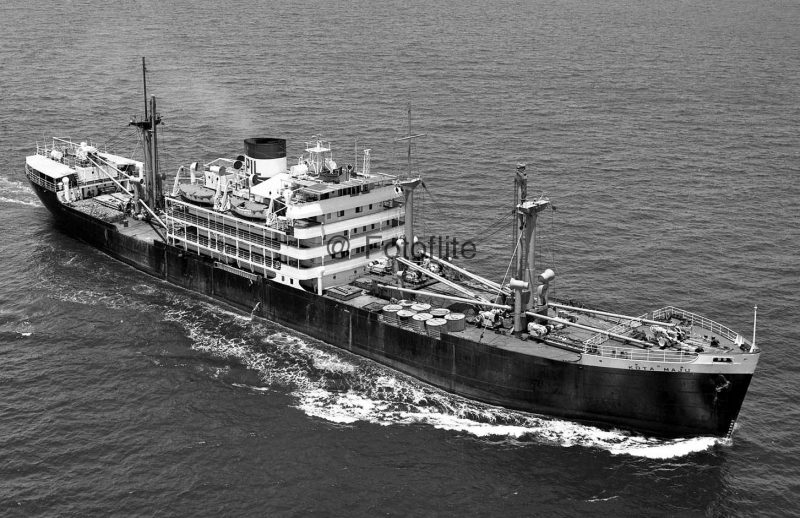
Singapore has always been a port of transit, re-exporting more than half of its imports of manufactured goods, oil refinery parts, and construction materials, as well as its exports of its own locally manufactured radios, cameras, watches and the excellent ‘Tiger’ brand of beer. The Tiger Brewery was known internationally and had brewed the ‘Tiger’ brand since 1931 on the Alexandra Road at Malayan Breweries, a joint venture between Heineken and a local brewer. The first PIL ships thus needed to be small shelterdeckers, sourced from the extensive KPM of Holland and China Navigation Co. Ltd. (Swire) fleets already operating in the region. The first two ships of PIL traded from Singapore to Jakarta and Bangkok and were of 2,660 dwt when purchased from KPM as Sinabang and Siberoet, completed in 1949 by the Van der Giessen yard at Krimpen, and were renamed Kota Naga and Kota Singa. This ‘Kota’ nomenclature has continued ever since, ‘Kota’ meaning hill or mountain, with plenty of these throughout South East Asia. Two similar shelterdecker KPM sisters quickly followed into the PIL fleet, Sigli and Sibigo, renamed as Kota Eagle and Kota Machan. Two China Navigation shelterdeckers followed in Shansi of 2,630 dwt built by Scott’s of Greenock in 1947, renamed Kota Rajah, and sister Soochow, renamed Kota Ratu, as well as Shonga of Elder Dempster and also of 1947 vintage, renamed Kota Matu. Kota Rajah and Ratu obtained charters from the Malaysian Shipping Corporation to carry troops in 1975, and were renamed Sang Suvia and Sang Fajar with their starboard side openings aft plated in.
A passenger trade was also operated by PIL between Whampoa in China, Hong Kong and Singapore with larger cargo-liners purchased with accommodation for up to 310 passengers in the Swire sisters Changsha and Taiyuan, renamed Kota Panjang and Kota Sahabut. They were built for the Australian service from Hong Kong, with Changsha having two embarrassing times during her Swire career. The first was on her maiden voyage in October 1950 when she broke down and was towed into Gibraltar, and the second was her long period ashore of six months at Nagoya in 1959 after being blown aground by typhoon Vera. The sisters now had double the accommodation with which they were built, by fitting metal bunks in the forepeak and aft ‘tween decks. Further passenger ships came from the Dutch owned KJCPL fleet in the sisters Tjiluwah and Tjiwangi, renamed Kota Bali and Kota Singapura. These were also built for the Australian trades, and PIL kept them trading to the same destination with the bottom of the holds converted to carry sheep. These four passenger ships had white hulls, and Kota Singapura took her name from the Sandskrit word for the ‘Tiger’ city of Singapore. Cargo-liners were purchased from British shipowners, including Ellerman Line, T. & J. Harrison, British India Line, Bank Line, Bibby Line, Jardine Matheson, and Pacific Steam Navigation Company (PSNC).
The PIL fleet had grown in size to thirty ships by 1973, with several ships then purchased from Dutch owners including from Royal Interocan Lines and the associated Koninklijke Java China Line (KJCL) e.g. Straat Towa, Straat Clarence and Straat Franklin renamed Kota Maha, Kota Chempaka and Kota Wirawan, and Nedlloyd Musi, built as Musi Lloyd for Rotterdam Lloyd in 1957 becoming Kota Sentosa (2) in 1977. The latter ship unfortunately capsized and sank on 3rd June 1981 when 150 miles west of Colombo during a voyage from Singapore Roads to Karachi, with only four survivors picked up from her boats a few days later by the tanker World Cavalier. Kota Gajah of 2,038 grt and built in 1965 settled in shallow water alongside the quay at Bangkok after fire had broken out on 5th July 1981 while she was discharging cargo, and was severely damaged aft.
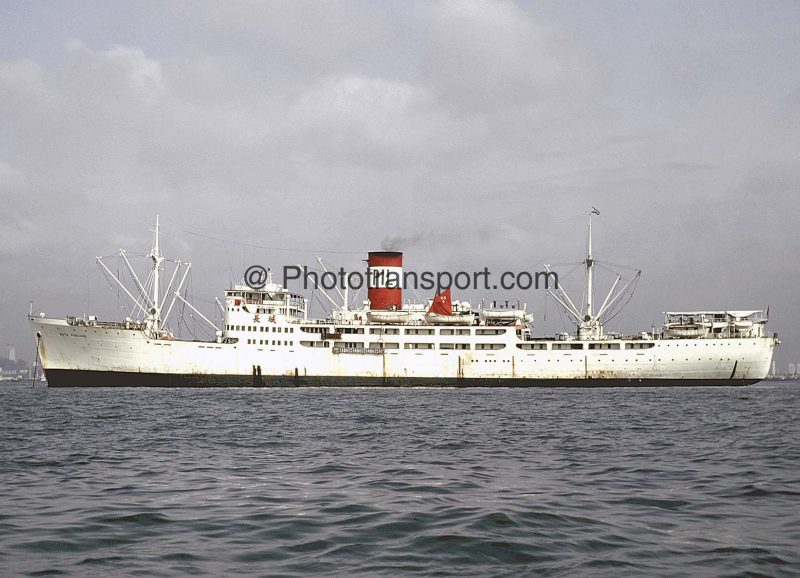
The fleet had reached fifty ships by 1981, by now trading to the Japanese ports of Yokohama and Kobe, the Indian and Pakistani ports of Bombay and Karachi, the Persian Gulf ports including Basrah, and Aden, Hodeidah (Yemen) and Aqaba at the northern end of the Red Sea. A further eight cargo-liners were purchased from Norwegian owners including Wilhelmsen, Fearnley & Eger, I.M. Skaugen, Bruusgaard Kiosterud, and Thor Dahl A/S. The German shipowners of Hapag Lloyd and Norddeutscher Lloyd sold four ships for further service with PIL in the Far East, with a quartet from Brostroms of Sweden, and another pair from Greek owners.
The several anchorages at Singapore always had black hulled PIL cargo ships waiting for berths, and the white hulled passenger and cargo ships Kota Panjang and Kota Sahabat, formerly with Swire, would disembark their passengers from Whampoa, Shanghai and Hong Kong at an anchorage near to Clifford Pier. They were sent for scrapping in 1980/81 and replaced in 1981 by the Spanish passenger and cargo ship Ciudad de Pamplona renamed as Kota Singapura (2). She was of 7,567 grt and had been built in 1964 at Valencia by the Union Navale yard for Trasmediterranea with accommodation for 136 passengers. However, the passenger trade from Whampoa, Shanghai and Hong Kong to Singapore ceased after she was laid up at Singapore Roads on 24th January 1984. The specialised livestock trade of sheep and cattle was carried out by Kota Temak, formerly the cattle carrier Al Kuwait, and completed by the Brodogradiliste yard in Jugoslavia in 1964.
From Breakbulk To Container
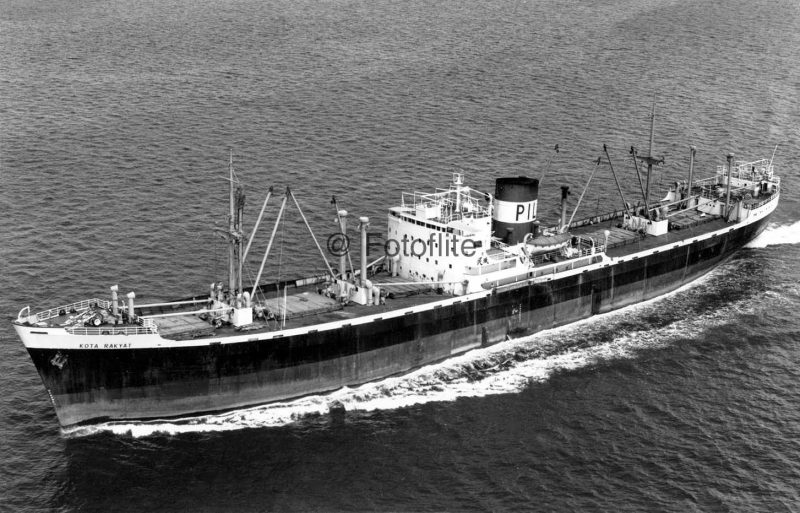
Feeder container ships were introduced by PIL into the Intra Asia trades in 1981 such as Sea Hawk built in 1973 and of 5,600 dwt and 316 TEU capacity on the main trade route between Jakarta and Singapore. She had been built as Manchester Zeal in 1973 by the Appledore yard in Devon. The PIL container ship Kota Sahabat built in 1977 as Strathkeith for P. & O. and of 7,750 dwt and 372 TEU capacity also began a container trade between Singapore and Hodeidah, Jeddah and Aqaba at this time. The similar sized feeder container ships Sea Fortune ex Kota Suria and Sea Glory followed a year later, with the semi container ship Kota Megah purchased from Mitsui-OSK Lines in 1983 as Caracas Maru, built by Mitsubishi in 1969. The Sea Containers Ltd. of London ro-ro and container ship Contender Argent completed in 1981 was chartered in 1987 for two years and renamed Kota Eagle with a big capacity for 920 lane metres of ro-ro cargo and 1,108 containers.
PIL later teamed up with several small Thai shipping companies to operate feeder container ships from Bangkok, and in the Indian Ocean feeder container trades with Bengal Tiger Line and others. The East African and South African trades were also entered in the early 1980s from Shanghai and Singapore using the part container ‘M’ class of Kota Megah, Kota Mewah, Kota Mulia, Kota Murni and Kota Mutiara. The similar Kota Mas was destroyed by shelling in the port of Basrah in August 1980 and abandoned to insurers. PIL had obtained a lucrative contract from the Chinese Government to ship Chinese technicians and technology for the oil, gas and railway and road infrastructure projects for the Chinese Government initiated projects in East Africa, as well as the shipment of Chinese and Singaporean manufactured goods to East Africa.
The bulk carriers Kota Harta and Kota Hasil of 34,200 dwt were completed for PIL in 1986 for the shipment of coal from Newcastle (NSW) to Chinese ports. The former Pacific Steam Navigation Company (PSNC) cargo-liner Ortega of 18,370 dwt when completed by the Cammell, Laird yard in July 1973 was purchased by PIL in 1987 as Oceanhaven and renamed Kota Akbar for a service to West African and East Coast of South American ports from Shanghai and Singapore. The PIL ‘W’ class of Kota Wangi, Kota Wangsa, Kota Waruna, Kota Wijaya and Kota Wirama were employed at this time on a service from Far Eastern ports and Singapore to Hodeidah (Yemen), Aden, Port Sudan, Jeddah and Aqaba.
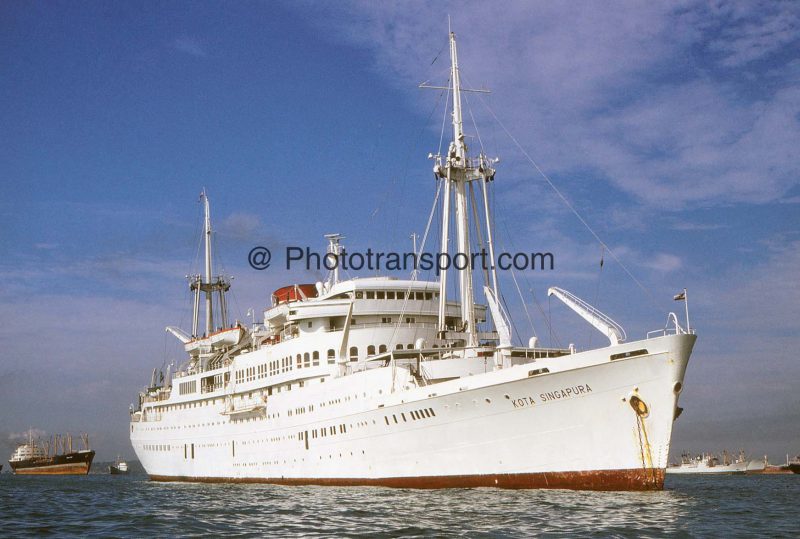
The PIL fleet of fifty ships in 1990 contained the recently purchased container ships Kota Indah and Kota Intan of 24,580 dwt and 640 TEU capacity and completed in 1976, equipped with four container handling cranes of 25 tonnes capacity, and the part container cargo-liner Kota Molek of 17,070 dwt and completed in 1971. Kota Sabas was purchased from ACT of London as ACT12 in 1991, and the first of the ‘W’ class was launched at Toyohashi in Japan on 9th January 1991 as Kota Wijaya, followed by six sisters over the next five years in Kota Wirawan, Kota Wajar, Kota Wangi, Kota Wangsa, Kota Waris, and Kota Waruna. They had a container capacity of 1,550 TEU and a deadweight of 22,700 tonnes and most are in the current fleet of container ships.
Container alliances with several shipping companies were being made at this time, including the Sindbad container service with Nedlloyd and with MISC of Malaysia on a slot basis from Singapore to Colombo, Bombay, Karachi, Rashid (Dubai) in 1991. The PIL fleet had moved up in size to 55 ships by October 1992 when a consortium of four shipping companies began a Singapore to Bangladesh service by PIL, OOCL, APL, and Sea Consortium, with ASXCL Shipping later joining in the pooling arrangement in June 1993.
Next Generation of Family Takes Over
In October 1992, the fifth son of the fourteen children of the founder took over as Managing Director of PIL, a total of ten of his children being involved in the running of the company. Teo Siong Seng is very much a leader at the Cecil Street headquarters of PIL in Singapore, and is affectionately known in worldwide shipping circles as ‘S.S. Teo’. He has much influence on the global shipping scene, and also controls Singamas Container Holdings as President in Hong Kong and China, the second largest manufacturer of container boxes in the world. He has many roles in addition to running PIL, including acting as an independent non executive director of China Shipping Container Lines (CSCL), President of the Singapore Chamber of Commerce, President of the Singapore Shipping Association, Chairman of the Singapore Maritime Foundation, and a nominated member of the Singapore Parliament. He also sits on the trade councils of three Chinese municipalities and has been an honorary citizen of Foshan and Yixing provinces in China since 2004.
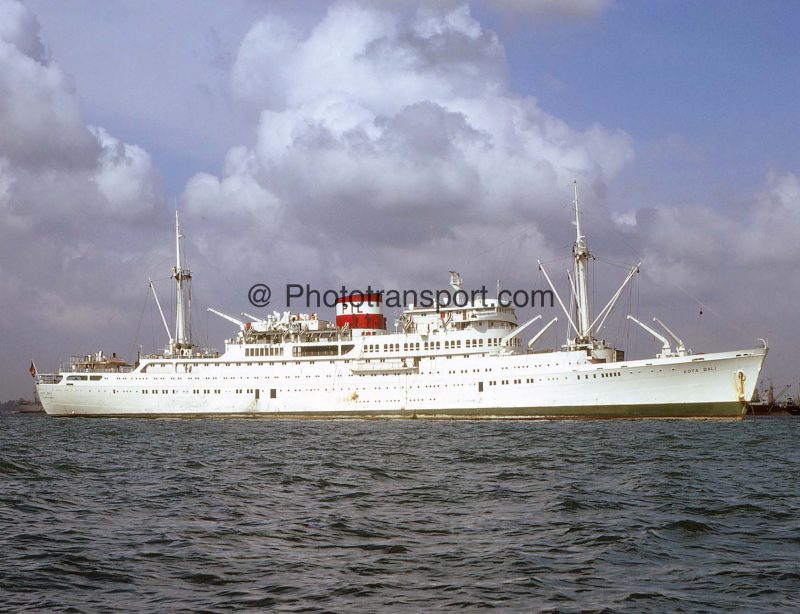
Teo Siong Seng then invested in four new distribution centres in China in Shanghai, Ningbo, Wuxi and Guangzhou, as well as a new container terminal in Hong Kong in partnership with Sinotrans of China, and an Initial Public Offering (IPO) of HK$100 million to float Singamas Container Holdings on the Hong Kong Stock Exchange. A slot exchange service between PIL and Hyundai Merchant Marine on the Singapore to South Korea service began in March 1993, along with ‘K’ Line joining the Singapore to India and Persian Gulf partners of PIL, MISC and Nedlloyd. At the end of 1993, PIL had a new weekly Singapore to Madras service using two feeder container vessels, a new service to the North Japanese port of Hachinoche from Singapore, and an Eastern African service in partnership with MISC, Mitsui OSK, NYK and Nedlloyd.
On 2nd December 1994, Kota Suria collided with the Philippines passenger ferry Cebu City of 2,452 grt in Manila Bay. The ferry was owned by Williams Lines of Manila and sank with the loss of four hundred lives. Cebu City was found responsible for the collision at the searching subsequent inquiry as she had unexpectedly crossed the path of Kota Suria without warning. The Australia Express Service from Singapore to Brisbane, Wellington and Auckland in partnership with OOCL, MISC and Mitsui OSK was stepped up in January 1996. PIL began a weekly service calling at the new container terminal at Port Klang from Singapore in September 1997. The container ship Kota Indah was accused of damaging an underwater power cable while anchoring at the inner anchorage of Surabaya in 1999, and the subsequent $7.5 million damages award was contested by PIL in the Indonesian courts for more than eight years. Kota Waris was the first ship to dock at the new Aden Container Terminal during 1999 on her Red Sea service from the Far East.
At the Millennium, PIL had a big fleet of 55 owned breakbulk and container ships and many more on charter, forty of which had ‘Kota’ prefixes to the names, and eight had ‘Sea’ prefixes to their names in Sea Bright, Sea Elegance, Sea Express, Sea Gallant, Sea Glory, Sea Horse, Sea Marine, and Sea Ocean. The former Blue Funnel cargo liner Memnon of 21,080 dwt completed at the Nagasaki yard of Mitsubishi Heavy Industries in 1977, was one of the fleet that did not conform to these two nomenclatures, as she traded as Hai Xiong until she arrived at a Mumbai shipbreaking yard on 31st December 2001. Joint ventures and subsidiaries were set up as Advance Container Line (ACL), Pacific Eagle Line (PEL), and Pilino Megah Selatan (PMS) of Indonesia. In September 2000, PIL began an updated service to West Africa via South Africa, and by the end of the year a direct container service operated from the Far East and Singapore to India in a consortium of PIL, ‘K’ Line, Shipping Corporation of India, and Dongnama of South Korea. This developed into a five vessel service with two loops, one from South Korea to Mumbai and one from Shanghai to Chennai.
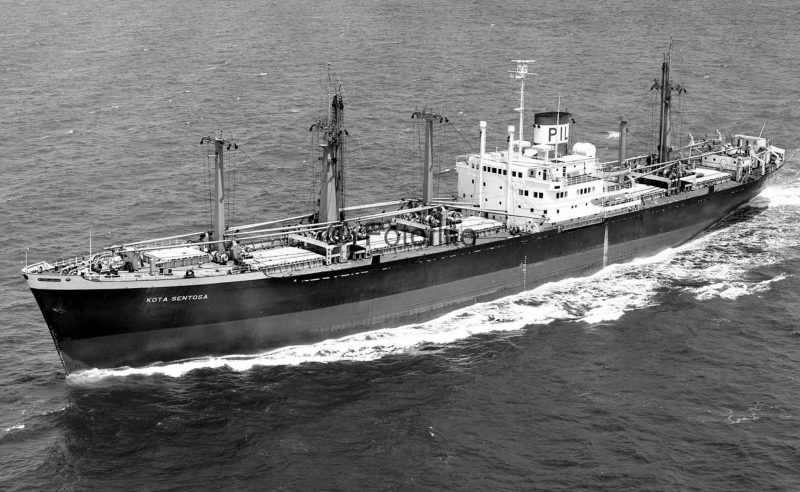

American Special Forces personnel boarded the feeder container ship Kota Sejarah of 732 TEU capacity in December 2001 in search of contraband and terrorist activity, unfortunately two crew members were injured during the boarding. The container ship Kota Hadiah of 1,088 TEU capacity collided in Hong Kong harbour on 12th March 2002 with the dredger A.M. Vella with an unfortunate loss of eight lives, one confirmed dead and seven missing. In July 2003, four Kien Hung ships built in 1999 were purchased for $73.2 million. Four new container ships of 37,100 dwt and 2,475 TEU capacity had just been completed as Kota Ganteng, Kota Gemar, Kota Gembira and Kota Gunawan. By the start of 2004, PIL had become the biggest Intra Asia operator with a fleet of 95 owned and chartered container vessels, with Wan Hai Lines as the second biggest operator and a close partner of PIL with a joint entry into the competitive Asia to Europe container trades in 2004.
No trade was too small for PIL to handle, an example being the Pasminco zinc trade in containers from Bell Bay in Tasmania with direct calls by container ships owned by PIL, MISC, MOL, OOCL and ANL. These zinc cargoes were formerly loaded at Hobart but then were switched to Bell Bay and Burnie in Northern Tasmania. The Australia to China Express service was updated by PIL with five container ships each of 1,500 TEU capacity in April 2004. A year later, a new joint PIL and MOL service to the East Coast of South America via South Africa was operating with three container ships supplied by PIL and eight container ships supplied by MOL. Three new sister container ships of 39,900 dwt and 3,080 TEU capacity entered service during 2005 as Kota Kado, Kota Kamil and Kota Kaya. Six feeder container ships of 850 TEU capacity began a joint service by PIL, MOL and Laurel Navigation of Mauritius from India and Pakistan to East and South Africa in September 2005, with two ships from each line. The South African and West African service was strengthened by PIL and MOL in September 2005 to thirteen ships, seven of 1,800 TEU capacity from MOL and six of 1,300 TEU capacity from PIL.
Top Twenty Container Line
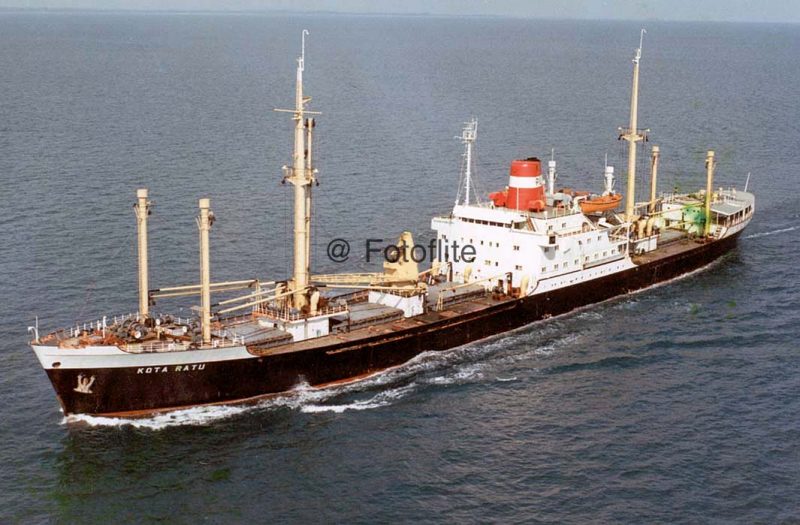
Erratum: We are grateful to John Andrews from Dunedin, New Zealand for pointing out an error :- The photo is not Dorit Skou, which is engines aft. It is the former Straat Luanda of Royal Interocean Lines, built as Van Linschoten in 1957 by Gusto Werf at Schiedam. Of 6,877 grt she was lengthened in 1967 and renamed that year as Straat Luanda. PIL purchased her in 1978 and renamed her Kota Ratu. On 13.2.1984 she arrived at Nantong for breaking up by Jiangsu Shipbreaking Company.
The company entered the top twenty container fleets of the world in March 2006 at position nineteen, with an annual turnover of two billion dollars and a fleet of one hundred owned container ships and multi purpose ships with eight more sold off and leased back for eight to ten years. A few months later, PIL gained a majority interest in the Pacific Direct Line, a family owned shipping company in New Zealand. PIL served New Zealand with a weekly two loop service in a consortium with MISC, MOL, NYK and OOCL. The numerous newbuilding container ships delivered at this time included fourteen ships of 4,250 TEU capacity as the ‘L’ class, and three ships of 6,600 TEU capacity from Dalian Shipbuilding in China, the latter completed as Kota Carum, Kota Cahaya and Kota Cantik. This increased the slot capacity of PIL by 2009 to in excess of 200,000 TEU. Three more ‘C’ class container ships of 6,600 TEU capacity were later completed in 2012/13 as Kota Cepat, Kota Cabar and Kota Cempaka.
Cabotage regulations in Australia forced loading of Kota Ekspres at Sydney to be halted on 19th March 2006 at the order of the Department of Transport and Regional Service of the Australian Government. The containers were meant to be loaded onto a coastal vessel and this was a genuine mistake. Kota Pahlawan was boarded by Australian firefighters on 22nd June 2006 off Brisbane after a large gas cloud had escaped from toxic chemicals leaking from containers on deck. The vessel was escorted into Brisbane and the containers were offloaded.

The Trans Pacific service was entered by PIL for the first time on 17th March 2007 with one container ship of 2,500 TEU capacity, joining four other ships of the same slot capacity of an existing Wan Hai Lines service that had been running since 2001. PIL and Wan Hai Lines had signed a ten year strategic alliance at this time covering container ship services, shipbuilding orders, ship repair and terminal co-operation. The PIL berth in Singapore was now a three berth dedicated terminal of the PSA Singapore Terminals. PIL were using five container ships of 2,000 TEU capacity from Chinese ports and Singapore to Jebel Ali (Dubai) in the United Arab Emirates at this time in a joint service with ‘K’ Line.
Trade Downturn In 2008
A severe drop in freight rates throughout the world towards the end of 2008 resulted in one billion dollars of operating losses being posted by PIL by the end of 2009, with a similar 64% drop in profits at Wan Hai Lines, the main partner of PIL. Two existing China to Middle East loops were combined into one by PIL, Wan Hai Lines and ‘K’ Line when the first freight rate drops were experienced in October 2008. The joint PIL and Wan Hai Lines Asia to Europe service was suspended in December 2008, with slot charters taken on bigger COSCO container ships instead. Further deterioration in freight rates led to the ending of the Trans Pacific service of PIL and Wan Hai Lines at the beginning of 2009, and slot charters were taken on the ‘K’ Line PSW1 Pacific service instead, again using bigger container ships. A planned restructuring of the Far East to East Coast of South America by PIL and ‘K’ Line did not take place in June 2009 due to the downturn, ports served would have been Shanghai, Ningbo, Hong Kong, Shekou and Singapore to South African, Brazilian and Argentinean ports.

The Asia to Europe and the Asia to West Coast America services were suspended for most of the following four years, with only brief reactivations during 2010 and 2011 when rates improved slightly. In worsening trade rates in May 2011, the Asia to Europe container service was suspended again after being reactivated for a short while from six ports in China plus Singapore to a much reduced loop to European ports after the Suez Canal and Alexandria. The Trans Pacific service by PIL, Wan Hai Lines and COSCO was slashed again in September 2011 as freight rates continued to tumble with only two weekly services from Qingdao in China. PIL was only in ‘the red’ with financial losses for one year (2009) of the four year volatile period from 2009 to the end of 2012.
Kota Wajar was hijacked by Somali pirates on 15th October 2009 to the north of the Seychelles en route to the East African port of Mombasa. The CEO of PIL, Teo Siong Seng, was in East Africa at the time on a Trade Mission and remembered well the difficulties encountered in making contact with the hijackers for the release of 28 officers and crew members and the vessel amid constant threats of harm being made. The CEO flew back to Singapore to conduct negotiations over a satellite phone link to eventually free the crew safely and release the ship after 75 days of captivity on 28th December 2009. Armed guards then sailed on the ships to the East African and Red Sea trade lanes.
Kota Kado ran into an underwater obstruction at Hong Kong in June 2010 while on a voyage from Nansha in China to Singapore. She was partly sunken by the bow with the forepeak tank, several double bottom ballast tanks and the forward holds flooded, and was beached to save her from sinking. Svitzer Salvage removed all of her bunkers and partly discharged her containers to lighten the vessel using crane barges, Typhoon conditions slowed the work of refloating the vessel, but she was eventually towed into shallower water at Hong Kong on 30th June, and then moved to a repair yard to complete the discharge of her cargo and patch her forward areas alongside a quay before permanent repairs were made.
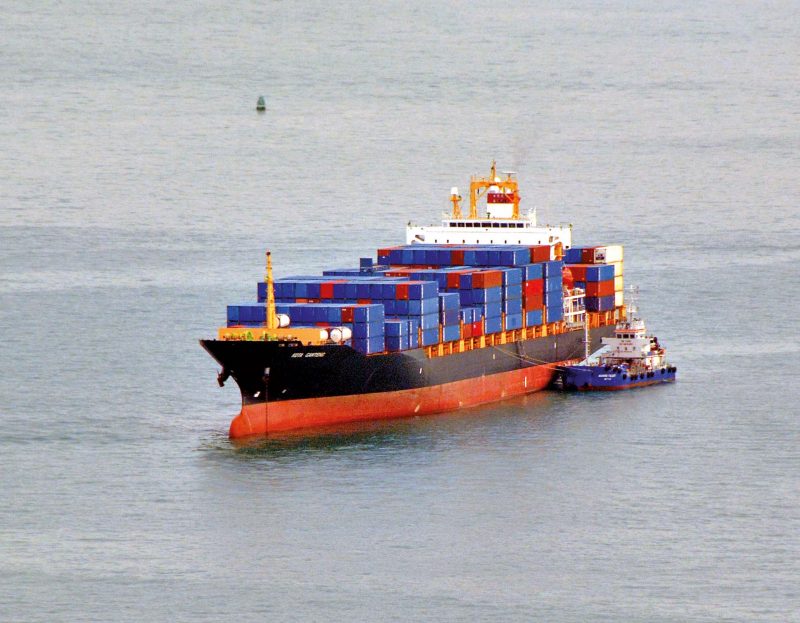
Freight rates began to improve in late 2011 on the Trans Pacific route, with PIL then offering a service from Long Beach to New Zealand and Australian ports to supplement its three loop service from South East Asia to Australia and a one loop service to New Zealand ports. Direct container services were then introduced to Vladivostock from the PIL Northern China and Japan service calling at Niigata in Japan. The direct PIL service from Chinese ports to Bangladesh was beginning to show improvements in loading as shipment times and costs had been slashed.
A large fleet of 137 owned and chartered container ships of 263,797 TEU was owned in 2012, with joint services with Wan Hai Lines to Europe and in the Trans Pacific trades. Disruption in the Malaysian, Singaporean, and Indonesian feeder container services was caused by the sudden departure of MISC of Malaysia from all container services in 2012. Three container ships of 3,800 TEU capacity were ordered from Dalian Shipbuilding in China in October 2012 with options for five more. The ships were to be used on the weekly East African and Indian Ocean service operated jointly with MOL of Japan. A bad fire on the chartered Leonhardt & Blumberg container ship Hansa Brandenburg of 1,740 TEU capacity on 17th July 2013 occurred when she was 200 miles north east of Mauritius. A forward cargo hold and the crew accommodation area were badly damaged while she was on a voyage from Singapore to Durban, her seventeen man crew were rescued by the passing container ship Donau Trader. The chartered ship arrived safely at Port Louis in Mauritius and temporary repairs were made.

The Singapore ‘Tiger’ PIL reached position fifteen in the Top Twenty container fleets at the start of 2014, having recorded a 25% increase in slot capacity during 2013. The PIL main trading routes were in the Intra South East Asia trades, China and South Korea to the Persian Gulf, Red Sea, and Middle East with extensions to the Black Sea ports of Odessa and Constantza, and Chinese ports and Singapore to East, South and West Africa with calls at Durban, Cape Town, Pointe Loire, Luanda, Lobito and ports in West Africa. There were two loops to South African ports, one from Central Chinese ports, and one from Southern Chinese ports. There were also loops to serve the Trans Pacific trades and Australian and New Zealand ports.
A majority 55% interest was acquired in Mariana Express Lines in March 2015, an Asia to South Pacific islands specialist trader with many routes to Polynesia and Micronesia from the hub ports of Hong Kong and Kaohsiung and calling at Saipan and Guam.
This line was founded in 1997 by the Au family, and was using eight chartered container ships of capacity from 650 TEU to 1,700 TEU as well as one owned multi purpose ship at the time of the acquisition.
At the end of 2015, PIL was operating a fleet of 112 owned vessels with 20% of its fleet chartered out. The fleet ranged in size from 600 TEU to 6,600 TEU capacity, and 8 new container ships of 11,800 TEU were on order for delivery during 2017/18 from a Yangzjiang yard in China, which would join the three dozen ships already completed by Dalian Shipbuilding for the company. PIL was operating in a six container ship service from Chinese ports to India at this time in a consortium with Wan Hai Lines, Mitsui OSK and Interasia Lines.
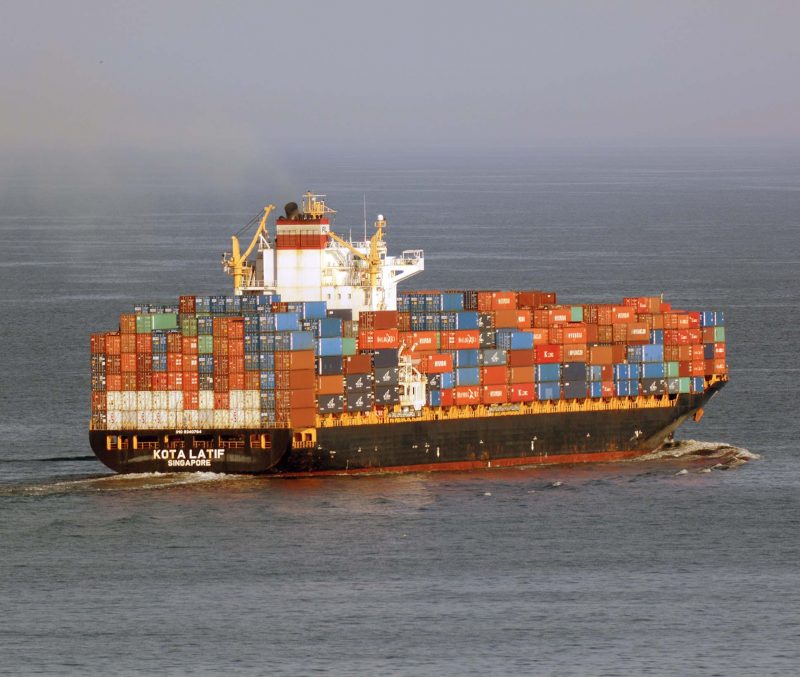
Postscript
Pacific International Line (PIL) has developed over five decades from a coastal operator in Singapore to become one of the largest shipowners in South East Asia. Today, it has a top twenty container line ranking of fifteen, and offers container liner services and multi-purpose services at over 500 ports worldwide in one hundred countries with a fleet of 160 owned and chartered vessels e.g. Kota Ekspres of 3,765 TEU capacity is on charter from XT Management of Israel but was originally built for Hamburg Sud in 2013 and is trading in 2017 from Melbourne and Tauranga to Alameda in California.
PIL is also heavily involved in container manufacture, with its wholly owned subsidiary of Singamas Container Holdings of Hong Kong and China the second largest box manufacturer in the world. Other activities include logistics and freight forwarding, warehousing and distribution, rail and multi-modal transport services, container terminal operations, ship agency work, marine services and real estate.
At the end of 2016, PIL had a dozen container ships on order from Chinese yards, but apart from its strategic alliance with partner Wan Hai Lines, did not feel disadvantaged by its size relative to the league of big container ship lines, as it operated in niche markets with lower exposure to volatility in freight rates.
The ‘Tiger’ economy of Singapore is still powering ahead in 2017 with the Tiger Sky Tower and the casinos on Sentosa Island, and ‘Tiger’ brand beer, doing good business, and cruise ships docking regularly at Marina Bay. The resourceful Teo Singaporean Chinese family are well steeped in the business of shipping, and celebrated the half centenary of ‘PIL’ on 16th March 2017 in some style.


I wish them well for the next 50 years, and also wish to sincerely thank their excellent website www.pilship.com.
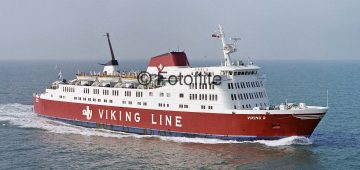
Comments
Sorry, comments are closed for this item